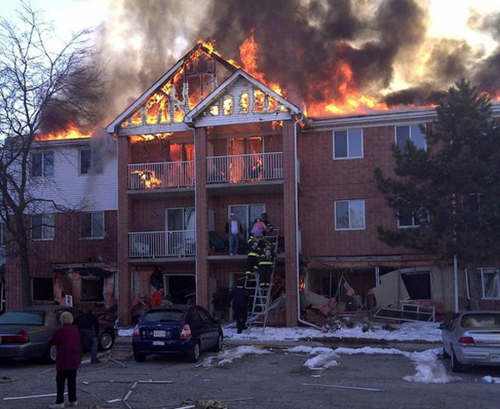Fires & Explosions
Abandoned oil and gas wells
Oxford County is home to approximately 500 abandoned oil and gas wells in rural areas, which could create risks to human and environmental health. These risks include fires or spills and flammable or combustible environments.
If you think there is an abandoned well on your property, do not investigate yourself. An abandoned oil and gas well must be plugged in by a professional contractor to meet today’s regulatory standards. If you suspect an abandoned well on your property, contact the Ministry of Natural Resources and Forestry Petroleum Operations Section via email at posrecords@ontario.ca or 519-873-4634.
Home Fires
There are 20,000 house fires in Canada in an average year, resulting in 300 deaths and more than $500 million of property damage. Smoke and toxic gases kill more people than flames do. Breathing even small amounts of smoke and toxic gases can make you drowsy, disoriented, and short of breath.
Does your family know how to escape if there were a fire in your home? You may have only a few minutes to get out safely once the smoke alarm sounds.
Carbon Monoxide Safety
It is now the law to install a carbon monoxide (CO) detector in your home.
For more information on Carbon Monoxide and Fire Safety visit the Office of the Fire Marshal
General Fire Safety Tips
- If a fire occurs in your home, GET OUT, STAY OUT and CALL for help.
- Install smoke alarms on every level of your home, inside bedrooms and outside sleeping areas (it’s the law).
- Test smoke alarms once a month, if they’re not working, change the batteries.
- Talk with all household members about a fire escape plan (have two ways out, define a meeting place) and practice the plan twice a year at different times of the day and night.
- Teach children to escape on their own in case you can’t help them.
To reduce fire risk during a power outage:
- Electrically-connected smoke alarms and carbon monoxide alarms will not work when the power is out unless they have battery back-ups. Make sure your home has battery-operated smoke alarms and carbon monoxide alarms.
- Use flashlights or battery-operated lanterns instead of candles. If using candles, place them in a secure holder and cover them with a glass chimney, away from children and pets.
- Propane and charcoal barbecues are for outdoor use only. Do not bring them inside.
- Make sure electric stove elements and small appliances are OFF or unplugged to prevent fires from occurring when the electricity is restored.
Explosions
It's not hard to forget the devastating explosion at a Woodstock apartment building in 2011. The results can be catastrophic when certain chemicals, gases, and other substances are kept in an unstable state or are exposed to heat or fire. If an unstable substance explodes, the blast may cause serious injuries or even death. Explosions and blasts may be caused by improper transport, storage, or treatment. It is important to understand the different types of explosions and where they typically occur in order to keep yourself as safe as possible.
Common Types
- Propane
- Natural Gas
- Fuel
- Petroleum

Chemical spills
Hazardous materials are chemical substances, which if released or misused can pose a threat to the environment or health. A hazardous materials accident can occur anywhere. Communities located near chemical manufacturing plants are particularly at risk. However, hazardous materials are transported on our roadways and railways daily, so any area is considered vulnerable to an accident.
Even if a municipality does not have a hazardous material commercial or industrial facility, an incident may be caused by the transportation of dangerous goods near or through the area.
Whether it be an accidental chemical release due to a train derailment or fire at an industrial facility, be prepared by knowing what to do if a chemical/hazardous materials incident affects your area.
Visit your Community Page for information on what hazardous materials may exist and how you can be prepared.
Depending on the situation, you might be asked to "shelter-in-place". Learn more about what this means.
General Tips
- Listen for official advice
- Emergency responders are trained to identify hazards and provide appropriate guidance to the public.
- In some situations, you may be asked to Shelter-in-Place. Other times, you may be instructed to evacuate the area.